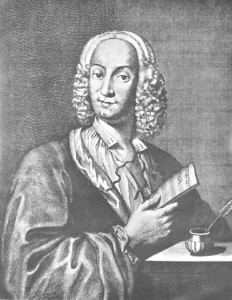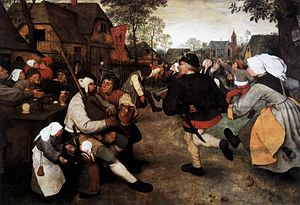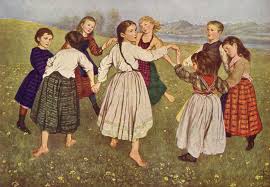VILLAGERS’ DANCE
Vivaldi’s L’Autunno
from The Four Seasons
First Movement ‘Allegro’
Ballo e Canto di Villanelli
The Dancing and Singing of Villagers
Introduction
This project is based around aspects of the music of Vivaldi’s famous violin concerto ‘Autumn’. It provides materials for widely differentiated teaching, with some very simple exercises and others which are quite sophisticated. Guidance from a teacher will be useful.  Vivaldi’s score is prefixed by a short Sonetto Dimostrativo – a short poem depicting the ‘action’ the music represents. The ritornello theme points to the dancing and singing of villagers to celebrate the harvest and the episodes, which feature the solo violinist, represent those villagers who succumb to the influence of the wine and eventually finish their revelling in a deep slumber. Our ear is led back and forth from the dancing of the whole village to scenes of individuals’ merriment, as if the scene were being filmed for television. An extremely modern concept for 1730!
Vivaldi’s score is prefixed by a short Sonetto Dimostrativo – a short poem depicting the ‘action’ the music represents. The ritornello theme points to the dancing and singing of villagers to celebrate the harvest and the episodes, which feature the solo violinist, represent those villagers who succumb to the influence of the wine and eventually finish their revelling in a deep slumber. Our ear is led back and forth from the dancing of the whole village to scenes of individuals’ merriment, as if the scene were being filmed for television. An extremely modern concept for 1730!
To study and draw lasting musical skills from this piece, the project Autunno I focuses on both the ritornelli and the episodes
- Simple ensemble playing (ritornello);
- understanding, identifying and composing with sequence (episodes);
- large-scale improvisation and composition from small musical germs (ritornelli & episodes).
There is much useful support material and extension materials, including introducing how to read and analyse a musical score .
Age range: 2-5 No: 6-8 No; 9-11 possible, in part; 12-13 maybe;14-15 works well; 16-17 very useful; 18+ very useful.
-
Expected prior achievements of students
Reading and playing simple melodies in the treble clef essential (alto and bass clef options, too) ; some experience of working in F major with I, IV & V chords desirable; building melodies from sequences (practical preparatory worksheets included in this project)
-
Goals and aims of project
By the end of this project students will: (a) have developed ensemble performance skills in a short rendering of the opening theme; (b) have developed improvisational and composing skills by both learning to work with sequence (melodic and harmonic) and form (rondo/ritornello); (c) have developed confidence in writing melodies; (d) be able to follow a score with understanding of the musical content; (e) be well informed about the baroque concerto.
-
Project materials in text & media form
- Preparatory notes for the teacher.
- Explanation & examples of the term sequence (information sheet)
- Aural and visual sequence identification (worksheet)
- Composing melodies using sequence (Worksheet)
- Creating the “Villagers’ Concerto”: Working with the MIDIfile Autunno1.MID (worksheet)
-
Project materials in adaptable musical formats
The Villagers’ Dance – MIDI-file: full opening 13 bars of Vivaldi’s “L’Autunno” AutumnRitFull; simplified version (using repeat signs, each phrase in same octave) Autunn01
-
Project materials in musical notation
Opening ritornello in gif format – full version – simplified version ![]()
Opening ritornello (simplified) in Opening theme in pdf format Villagers’ Dance (simplified); full version Villagers Dance
-
Suggestions for working with the materials (including essential preparation)
Preparatory notes for the teacher
-
Further materials and useful background information to the music of the project
The Rise of the Concerto in Italy in the 17th and early18th Centuries
Information sheet with links and illustrations – Also used in Basso Continuo (Vivaldi’s L’Autunno II) project html format ; . pdf.format (with illustrations, no links): concerto origins
The Violin
Information sheet with links and illustrations – Also used in Basso Continuo (Vivaldi’s L’Autunno II) project html format; . pdf.format (with illustrations, no links) violin-viol
-
Suggestions for following up the project including links to related music, books, sites etc.
Link to Amphionmusic’s Autunno II to understand the idea of contrasting movements and to develop a much more in-depth understanding of basso continuo.
- Author: John Mason
© John Mason


